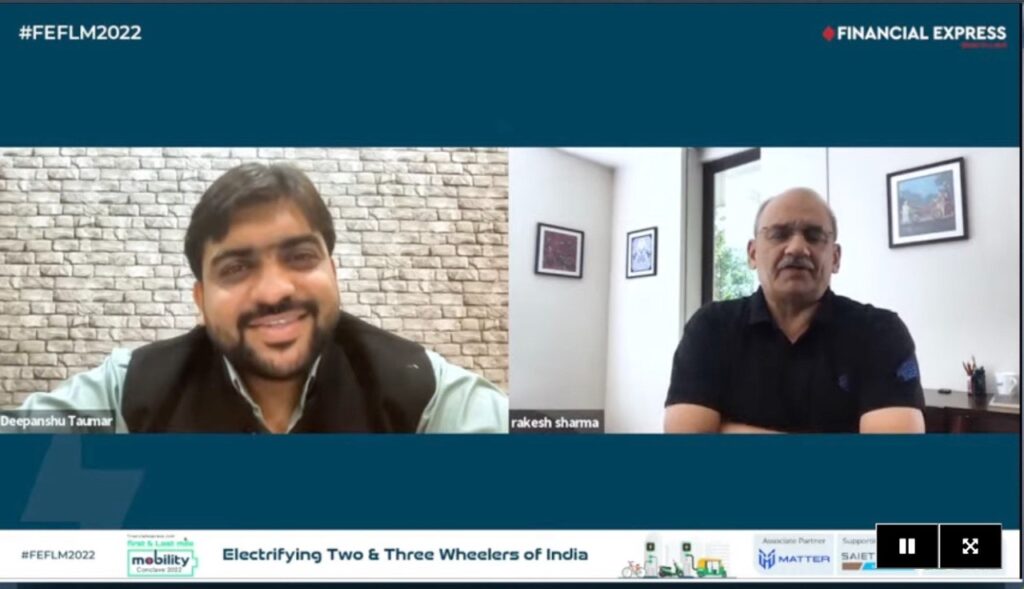The two-wheeler segment caters to a wide audience — from commuters to passionate enthusiasts. However, the commuter segment contributes to the largest chunk of sales for two-wheeler manufacturers. When sales seemed like it was sailing on good waters, the pandemic wave brought the market crashing down, which is still on the road to recovery.
This was a big blow to the industry as a whole, especially when OEMs were testing grounds for EVs. To understand the situation better, Mr Rakesh Sharma, Executive Director, Bajaj Auto spoke to Mr Deepanshu Taumar, Deputy Editor, The Financial Express at the First & Last Mile Mobility Conclave 2022 hosted by The Financial Express. Sharma said, “I would say that the two-wheeler segment is an index of the well-being of certain segments of our economy.
About 60 to 70 per cent of our customers are in the lower half of the demand pyramid, even before the pandemic struck. Because of a variety of factors, including an increase in costs, which led to price hikes, and against a backdrop of an economy which was not thriving, the purchasing power of this segment started to weaken. ” The industry took a hit when the transition happened from BS-IV to BS-VI, which increased the cost of vehicles.
He adds, “After those price increments, demand had itself weakened. Then came two years of the pandemic, though it is now receding, people are more reassured, leaving this segment of customers economically weak. But the economy is moving up.
” However, in sharing his views on how the electric vehicle industry has seen a robust growth along with the number of start-ups that have sprouted, and on the future of Internal Combustion Engines (ICE) that still lead the sales, Sharma said, “It is indeed a complex situation because again, there are factors which are driving ICEs into EV and there are certain factors which are restraining this transition. ” “The driving factors are the operating economics with fuel cost crossing Rs 100 and nudging towards Rs 120 mark, which has been a big trigger in the consumers’ mind. Customers are looking for the easy option which is the single biggest driver in my mind.
The second is, of course, the support the government wants to reduce its foreign exchange outflow in the purchase of oil, and the commitment to a cleaner environment. So, there is strong government support, whether it comes in form of subsidies, lower road tax, or PLI,” added Sharma. “However, in the last year, the sales cost has again gone back to 2019 levels, and it is unclear whether the sale costs in the next immediate term of one or two years or at least 18 months would lower or not.
Therefore, the acquisition cost of an electric two-wheeler would still be higher than a comparable ICE two-wheeler. I would say certainly, the transition is underway,” explained Sharma. Bajaj which had exited scooter space for a long time now.
The company saw an opportunity to make a comeback but with an electric product offering, it grasped the idea of bringing back an iconic name, the Chetak. Sharma explained, “When we first started to sense the opportunity of electric mobility, we knew it was going to first occur in the scooter segment because of the way the scooter format is, it lends itself more easily to a transition. ” Bajaj has been cautious over the testing and validation process of EVs, and at times, taking more time than anticipated, but is looking to launch a robust product.
The Executive Director added, “The unique feature about this transition is that it is not just the change of power pack from gasoline to electric, it is being accompanied by changes in the digital interface, the number of electronics in the vehicle, the interface between the machine and the customer and the ecosystem around it. ” For more on the discussion, watch the conversation on the link below on Rakesh Sharma’s view on the electrification journey ahead. .
From: financialexpress
URL: https://www.financialexpress.com/express-mobility/vehicles/2-wheelers/scooters-were-the-best-platform-to-help-transition-to-evs/2564130/
